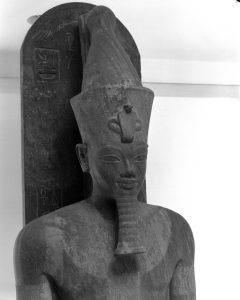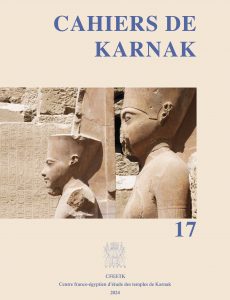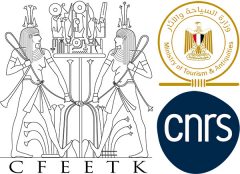
The CFEETK is very pleased to announce the online publication of the Cahiers de Karnak 17!
This volume is dedicated to the memory of Mohamed Al-Saghir, the renowned finder of the cache of statues in Luxor Temple, and Michel Azim, CFEETK’s archaeologist and architect.
It also includes 22 other articles: including reports on recent CFEETK activities at Karnak (restoration of the Tut’s statue of Amun, excavations in the Middle Kingdom courtyard, etc.), publications of monuments or objects and several studies.
This volume is currently available online on the CFEETK website, and the paper version will soon be printed.

— GABOLDE (L.), AL-TAHER (A.), « Introduction », Karnak 17, 2024, p. IX-X.
— GABOLDE (L.), « Michel Azim, l’archéologue, le chercheur, l’explorateur d’archives, le savant », Karnak 17, 2024, p. 1-6.
— GABOLDE (L.), « Bibliographie de Michel Azim 1975-2016 », Karnak 17, 2024, p. 7-10.
— AL-SAGHIR (M.), « Mohammed Al-Saghir, 25 juillet 1939‑30 juillet 2006 », Karnak 17, 2024, p. 11-12.
— AL-SAGHIR (M.), « Bibliographie de Mohammed Al-Saghir », Karnak 17, 2024, p. 13-14.
— ABD-EL-SATTAR (Sh.), « The Southern Chamber of Amenhotep II’s Edifice between the IXth and Xth Pylons at Karnak Temple », Karnak 17, 2024, p. 15-26.
— RAAFAT ABBAS (M.), « The Depictions of Three Ramesside Stelae in the War Scenes of Karnak », Karnak 17, 2024, p. 27-40.
— AL-TAHER (A.), « Khonsu and Montu Temples Graffiti Project: an Overview », Karnak 17, 2024, p. 41-54.
— CARLOTTI (J.-Fr.), « Les plaies de Karnak – la nature et l’Homme » , Karnak 17, 2024, p. 55-68.
— CHARLOUX (G.), ANGEVIN (R.), « Quarante ans après – Retour dans la cour du Xe pylône à Karnak » , Karnak 17, 2024, p. 69-78.
— DEMBITZ (G.), « La reconstitution des scènes de Toutânkhamon gravées sur la face extérieure du mur oriental de la cour de la Cachette » , Karnak 17, 2024, p. 79-106.
— DURAND (B.), « Une stèle d’époque romaine dans le temple de Ptah à Karnak », Karnak 17, 2024, p. 107‑112.
— FAWZY ALI (A.), « Female Figurines from the Excavations in Front of Karnak Temples », Karnak 17, 2024, p. 113-122.
— GABOLDE (L.), ET AL., « Report on the Excavations in the Middle Kingdom Courtyard 2020-2021 (OP191) », Karnak 17, 2024, p. 123-176.
— AL-TAHER (A.), GABOLDE (L.), HOURDIN (J.), « Rapport sur la restauration de la statue d’Amon de Toutânkhamon et sur les opérations complémentaires menées à cette occasion », Karnak 17, 2024, p. 177-194.
— GABOLDE (L.), GABOLDE (M.), « Compléments au texte de consécration du mur sud de l’Akhmenou », Karnak 17, 2024, p. 195-216.
— GOLVIN (J.-Cl.), « L’abattage de l’obélisque du VIIe pylône de Karnak essai de restitution de l’aspect du chantier », Karnak 17, 2024, p. 217-232.
— GOYON (J.-Cl.) (†), « Michel Azim et les archives de Karnak : un énigmatique chapiteau hathorique et la découverte de ceux du temple d’Opet », Karnak 17, 2024, p. 233-240.
— HOURDIN (J.), « Un document thébain de Néchao II usurpé par Psammétique II (Cheikh Labib 94CL1276) »Karnak 17, 2024,, p. 241-254.
— ISMAEL (Kh.), « New Study of a Relief of Dionysos Kept in Luxor Museum », Karnak 17, 2024,, p. 255-264.
— LAROCHE-TRAUNECKER (Fr.), MONNIER (Fr.), « L’érection et la fixation des mâts à oriflammes d’après la documentation relative au IIe pylône de Karnak », Karnak 17, 2024, p. 265-294.
— MEURICE (C.), « Formules, plagiats et surenchères entre voyageurs, le discours sur l’Égypte copte instrumentalisé », Karnak 17, 2024, p. 295-308.
— OLETTE-PELLETIER (J.-G.), « Le roi et l’oiseau, note sur trois emplois d’écriture énigmatique sur le pavillon jubilaire de Sésostris Ier à Karnak », Karnak 17, 2024, p. 309-320.
— PIETRI (R.), « Les talatates 29/137, 29/358 et 27/45 du IXe pylône de Karnak et la réception culturelle du char à l’époque amarnienne », Karnak 17, 2024, p. 321-332.
— THILL (Fl.), « De Saï à Karnak le rituel de fondation des temples égyptiens et son évolution au cours du Nouvel Empire », Karnak 17, 2024, p. 333‑374
— TRAUNECKER (Cl.), « Orientations réelles et imaginaires dans l’architecture égyptienne », Karnak 17, 2024, p. 375-390.
— VERGNIEUX (R.), « Une image dynamique des temples d’Aton figée dans la dispersion de ses vestiges au sein du IXe pylône du temple d’Amon-Rê à Karnak », Karnak 17, 2024, p. 391-398.
Please note that papers can still be submitted for the Cahiers de Karnak 18 until 31 December 2024 (see the announcement).



